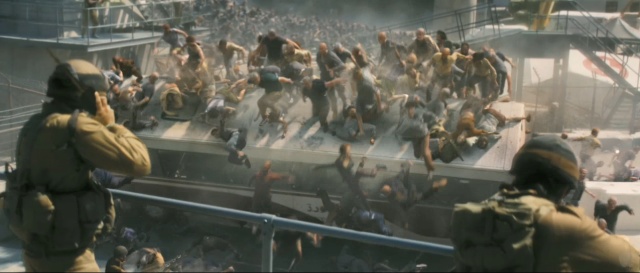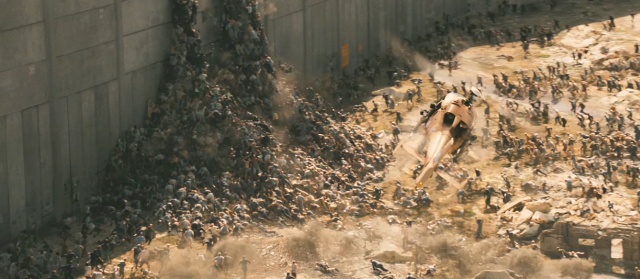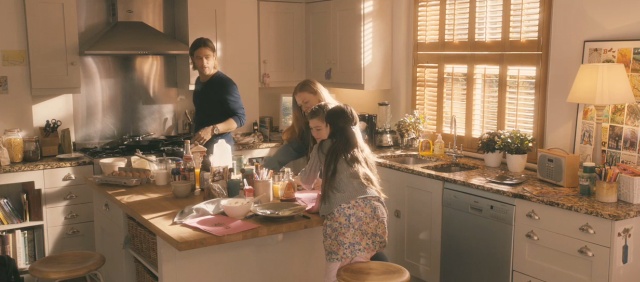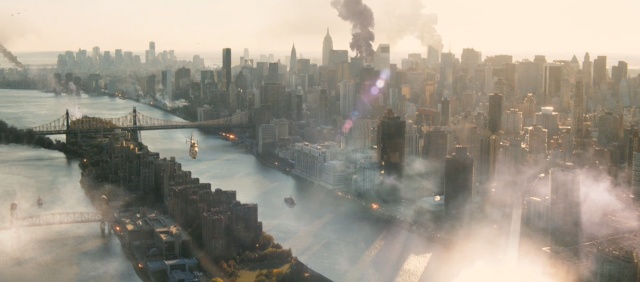World War Z (Marc Forster, 2013)

Max Brooks’ novel World War Z is a faux-documentary account of a zombie apocalypse, comprising a series of first-person accounts from around the globe as the undead take over. It essentially tries to game out the zombie apocalypse: if such an outbreak really occurred, using the rules we saw in George Romero’s classics, how it would actually play out? Could humans survive? And if so, how?
It’s an intriguing book, and its single-mindedness in thinking through its scenario to logical conclusions has justly made it a classic of the zombie niche. Yet it presents some obvious problems as a basis for a film narrative, and especially a big summer blockbuster. It lacks a central protagonist (the witness accounts are told to a central investigator character, but he’s essentially a passive, off-screen narrator). Its events take place over a decade, and in disparate locations. And it involves such massive, large-scale carnage that it presents budgetary problems for any adaptation. At the same time, those things that make it challenging to adapt are also much the same things that offer a point of difference from the glut of other zombie properties on the market (the 28 Days films, Romero’s Dead films, the Zack Snyder Dawn of the Dead, Shaun of the Dead, Zombieland, TV’s Walking Dead, and all the rest).
Marc Forster’s adaptation mostly takes the most obvious approach to the dilemmas of adaptation. It invents a central character, retired UN troubleshooter Gerry Lane (Brad Pitt, who as producer long championed the project), who after witnessing an initial outbreak is drafted back into service. This device creates a suitable plot motivation to zip around the globe visiting various hotspots, and it limits the action to the opening days of the outbreak to provide some manageable scope (not to mention plenty of potential for sequels down the track if the film is successful).
The film also switches from the Romero-style slow ghouls Brooks wrote about to the more fashionable fast zombies seen in films like 28 Days Later and the remake of Dawn of the Dead. This has obvious benefits in allowing for more kinetic action scenes, but a zombie aficionado friend of mine pointed out the problem for genre buffs: if such a large scale outbreak of fast zombies occurred, the “war” would surely be lost in days, and the scenarios that Brook explored – centred on how to resist a slow-moving but near-irresistible scourge – would never come to pass. This means that the film’s distinguishing point from other zombie films is instead just its sense of high-budget bigness, with the swarming zombies attacking like the orcs in The Lord of the Rings.

What is disappointing about World War Z, then, is that it fails to give us enough of those things that should be its focus. In 2011, Steven Sodebergh’s Contagion gave us a terrific portrayal of an apocalyptic scenario that was filmed with a keen eye for plausible detail. While a mass-market blockbuster such as World War Z couldn’t be as clinical as Sodebergh’s film, it still needed to start with that same sense of curiosity about the likely response to devastating events. That requires a focus on things normally at the fringes of narrative: the way institutions and governments respond to crisis; military tactics in the face of unexpected opponents; the impacts of mass devastation on an unprepared civilian population; the geopolitical implications of simultaneous worldwide conflict; and so on.
World War Z nods in some of these directions, but it is too focussed on narrative efficiency to explore such things in more than cursory way. The depictions of a global response to the zombie threat are done in such a cartoonish, compressed manner that they never feel real, and the ceaseless narrative movement doesn’t allow the film time to convincingly establish the various locales it visits. Ultimately this sacrifices what should make the film interesting. If you’re watching a film called World War Z and don’t get a plausible view of the world war, then the film is really just, well… Z.
Instead of focussing on such things, Forster takes the safe route by adding more direct human interest, as Lane must undertake his mission to ensure the protection of his wife and two daughters. Yet this material feels so generic that I’m not convinced it really gives the audience any more of a human “in” than a Contagion-like ensemble piece would. Is a UN peacekeeper who has retired and spent a single scene in a kitchen cooking breakfast for his kids more relatable than one who is established in his element doing the job that defines his role in the story? I’m not so sure: it seems like a lot of emotional heavy lifting to be done by toast and pancakes.

The film’s other distancing element is another designed to foster mainstream success. As a high budget movie, World War Z needs an American PG-13 rating. That in turn means little gore, and World War Z is a fascinating case study in how essential blood and guts are to the zombie genre. I’m not a fan of on-screen gore, but the visceral dread of dismemberment is what gives the zombie threat its power. By cutting the film to deliberately downplay the bodily horror of the ghouls, Forster (with the help, no doubt, of the studio execs looking over his shoulder) neuters his own film. This is particularly the case when so many sequences use CG zombie hordes: the close encounters with zombies needed more impact to impart the undead masses with some sense of tangibility.
This is one case, then, where an R-rated cut of the film may be a substantial improvement. It seems possible that whole sequences are gone or truncated for reasons of ratings or runtime: one key group of characters, for example, are carefully introduced early on only to go missing, presumed zombified, off-screen. Indeed, the way the film is cut – with staccato edits and overly curtailed exposition – you can constantly see the glimpses of a better movie peeking through, hinted at by pieces of scenes that survive but seem like they should be longer.
This hypothetical revised cut should also try to re-imagine some sequences and return them from the lowest common denominator approach we have in the theatrical release. In one scene, a group of elite soldiers ride on bicycles to maintain silence and avoid a zombie attack. It cries out for the tension of extended Rififi-like silence, but Forster instead opts to compress the narrative by having expository dialogue over the scene. It’s a false economy, in which a five-minute sequence is fatally diluted to avoid a static thirty seconds of exposition. Other, bigger sequences are similarly wasted because Forster rushes the details of character and geography that would help make them meaningful. This is a film that you suspect would seem fifteen minutes shorter if it were ten minutes longer.
I’m speculating, of course. The footage for such a cut may not exist. The film was a troubled production, with a third act that was heavily re-shot and which now seems like a whole separate film-within-a-film. These later sequences, set in a research lab, feel conspicuously lower budget but are better for it. (They also find a nice way to nod towards Romero-style slow zombies). Even then, though, there are moments you feel could have been better with a more assured director at the helm. The movie shifts more decisively to suspense mode, rather than action, but Forster doesn’t establish himself as especially proficient at either mode.

Looking over what I have written above it seems harsh. The film isn’t as bad as I’ve made it sound. What it is, though, is a missed opportunity. It’s one of those films where you barely need to squint to see the much better movie that was almost made.